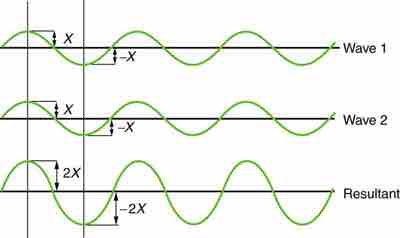Most waves do not look very simple. They look are often more complex than the simple water waves often considered in textbooks . Simple waves may be created by a simple harmonic oscillation, and thus have a sinusoidal shape. Complex waves are more interesting, even beautiful, but they look formidable. Most waves appear complex because they result from several simple waves adding together. Luckily, the rules for adding waves are quite simple.

Complex Pattern of Waves
These waves result from the superposition of several waves from different sources, producing a complex pattern.
Superposition
When two or more waves arrive at the same point, they superimpose themselves on one another. More specifically, the disturbances of waves are superimposed when they come together—a phenomenon called superposition. Each disturbance corresponds to a force, and forces add. If the disturbances are along the same line, then the resulting wave is a simple addition of the disturbances of the individual waves—that is, their amplitudes add.
Interference
As a result of superposition of waves, interference can be observed. Interference is an effect caused by two or more waves .
When two identical waves arrive at the same point exactly in phase the crests of the two waves are precisely aligned, as are the troughs . This superposition produces pure constructive interference. Because the disturbances add, constructive interference may produce a wave that has twice the amplitude of the individual waves, but has the same wavelength.

Constructive Interference
Pure constructive interference of two identical waves produces one with twice the amplitude, but the same wavelength.
If two identical waves that arrive exactly out of phase—that is, precisely aligned crest to trough—they may produce pure destructive interference. Because the disturbances are in the opposite direction for this superposition, the resulting amplitude may be zero for destructive interference, and the waves completely cancel.
While pure constructive and pure destructive interference do occur, they require precisely aligned identical waves. The superposition of most waves produces a combination of constructive and destructive interference and can vary from place to place and time to time . Here again, the disturbances add and subtract, producing a more complicated looking wave.

Superposition of Non-Identical Waves
Superposition of non-identical waves exhibits both constructive and destructive interference.